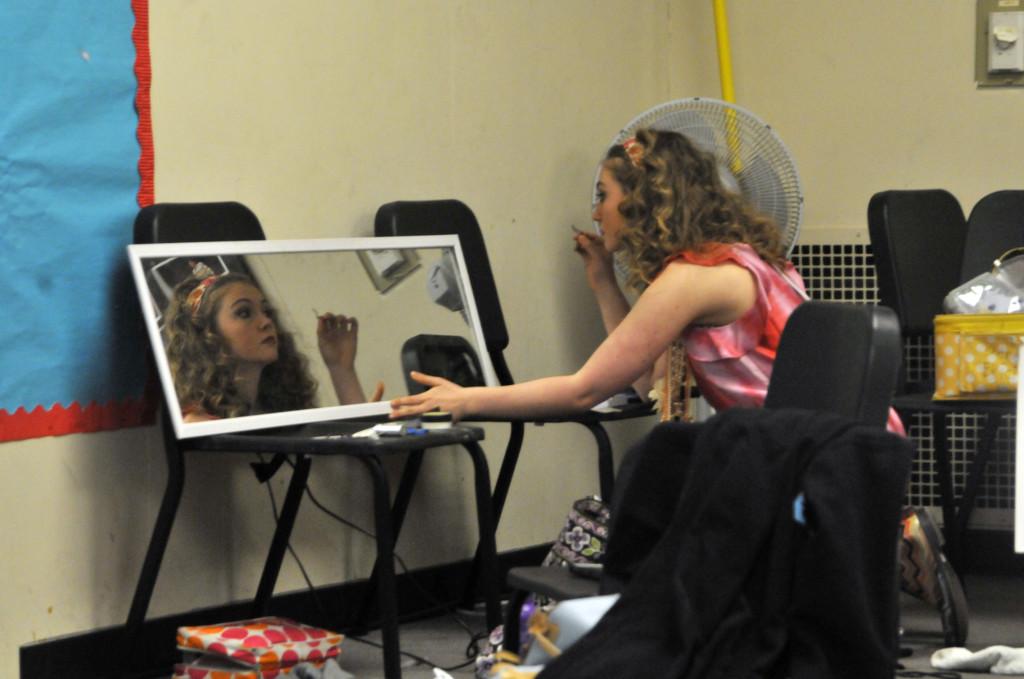A close look into the production of three SDS shows
Strains of French café music mesh with the chatter of performers as they prepare backstage for the first Student Directed Showcase (SDS) production. Directors and actors alike hurry from one room to the other, some practicing their roles, others gathering to chat with each other.
Having undergone the challenges of preparing D.N.A, The Choice Is Yours, The Shadow Box, and The Madwoman of Chaillot, respectively, this year’s SDS directors Hannah Prutton (12), Lori Berenberg (12), Cecilia Lang-Ree (12), and Cristina Jerney (12), along with their casts and technical crew, were closer than ever to the real performance.
Directing:
Casting
Since both the auditions and callbacks were so short, some directors had difficulty with the casting process. Instead of selecting students based off past experiences, actors were chosen depending on how well their personalities matched their characters’ roles.
“The casting process was difficult and incredibly stressful because you are choosing people for these roles with not very much evidence,” Hannah said. “The way that I looked at it was I wasn’t [thinking] ‘Oh, she’s done a lot before, so she should get the biggest part.’ It was really character-based and if someone fit a character perfectly and they’d already done a lot in the theater program, they would get the character that fit them perfectly.”
Because the four shows were so different, they required different personalities to fulfill the roles. This year’s directors worked well together in choosing actors for their shows, unlike some previous student directors who experienced complications with overlapping cast choices for their shows, according to Hannah.
Challenges
Among the obstacles the directors faced, the two most prominent difficulties consisted of leadership responsibilities and time management, according to performing arts department chair and SDS advisor Laura Lang-Ree as well as technical director Brian Larsen.
“I think it’s the same every year – directing your peers,” Lang-Ree said. “I can’t think of another leadership situation on campus where the peer has to be that much in charge, and that’s hard for anybody, especially teenagers, to allow that trust to happen.”
In addition, the time constraints for show preparation increased the number of tasks the directors needed to complete within a deadline. The production team had only two days to learn their cues, while the student directors and cast also had little time to rehearse, thereby making the directors’ leadership even more crucial to ensure progress.
“There’s generally more time with the spring musical at least. With these, we were dropped in on Wednesday, and the first show is two days later,” deck crew member Jeremy Binkley (10) said.
Props and Costumes
One of the directors’ numerous tasks included choosing props and costumes, for which they found inspiration in internet sources and various magazines.
“We had a budget of $400 for all the costumes and props, and we went out and we shopped around,” Cecilia said. “Some shows did more vintage shopping, some shows went to army surplus stores, some went to normal clothes stores, and it took me about a week to find all of my costumes that I needed for nine people.”
In order to stay within budget, the directors took advantage of the school’s costume closet by borrowing old props and costumes from past shows.
Technical staging:
Lights and Sounds
In addition to the directors’ months of work, the technical crew also played a crucial part in creating the show.
A large aspect of shows that often goes unnoticed is the lighting and sound effects. Though subtle, the successful implementation of stage effects can be attributed to the job of the technical crew. Working from the sound booth at the back of Blackford’s theater, the crew created the spotlight for the performers in the foreground.
“The whole point of our jobs is to help tell the story of the play or whatever we’re doing, so the less people notice us, the better our job has been done,” deck crew member Alex Thomas (10) said.
According to lightboard operator Nicholas Semenza (11), the shows in SDS are low-scale with only 80-100 cues, as opposed to bigger shows, which tend to have upwards of 300 cues.
However, the number of cues in the show did not detract from the excitement the technical crew had managing the effects.
“Part of the fun of running the shows is running the cues,” stage manager Simon Orr (12) said. “The fun part is seeing when that gets [messed] up. If you manage to [mess] it up and nobody notices and everybody thinks it’s perfect, that is fantastic and it’s such a good feeling.”
Set
In comparison to other shows, SDS incorporated platforms and stages that were already in stock or quickly put together as opposed to ones that required months of planning.
“Where [Paul] Vallerga and I get involved in it is helping [the directors] realize what they want up on the stage – getting the set put together, helping coordinate lighting and sound elements,” Larsen said.
Although the directors were not in charge of constructing the sets of their plays, they collaborated with the technical crew to plan out the final design.
“We went through a long and difficult process with Paul Vallerga where we described to him what we wanted, what our vision was, and we had him read our scripts, and we talked about it for loads of time and then he came to us with sketches,” Hannah said. “We looked at those together and kind of analyzed them and ripped them to shreds and started over again and kept going through that.”
After several months of production preparation, the showcase was presented at Blackford Theater on Friday, January 4, and Saturday, January 5.

Alex Jang, Student Life Editor for the TALON Yearbook, is a senior this year and has been a part of journalism for three years. In his free time, he enjoys...
Arden Hu, copy editor for the TALON Yearbook, is a senior and has been on staff for three years. She is also part of the varsity tennis team and enjoys...


















![“[Building nerf blasters] became this outlet of creativity for me that hasn't been matched by anything else. The process [of] making a build complete to your desire is such a painstakingly difficult process, but I've had to learn from [the skills needed from] soldering to proper painting. There's so many different options for everything, if you think about it, it exists. The best part is [that] if it doesn't exist, you can build it yourself," Ishaan Parate said.](https://harkeraquila.com/wp-content/uploads/2022/08/DSC_8149-900x604.jpg)




![“When I came into high school, I was ready to be a follower. But DECA was a game changer for me. It helped me overcome my fear of public speaking, and it's played such a major role in who I've become today. To be able to successfully lead a chapter of 150 students, an officer team and be one of the upperclassmen I once really admired is something I'm [really] proud of,” Anvitha Tummala ('21) said.](https://harkeraquila.com/wp-content/uploads/2021/07/Screen-Shot-2021-07-25-at-9.50.05-AM-900x594.png)







![“I think getting up in the morning and having a sense of purpose [is exciting]. I think without a certain amount of drive, life is kind of obsolete and mundane, and I think having that every single day is what makes each day unique and kind of makes life exciting,” Neymika Jain (12) said.](https://harkeraquila.com/wp-content/uploads/2017/06/Screen-Shot-2017-06-03-at-4.54.16-PM.png)








![“My slogan is ‘slow feet, don’t eat, and I’m hungry.’ You need to run fast to get where you are–you aren't going to get those championships if you aren't fast,” Angel Cervantes (12) said. “I want to do well in school on my tests and in track and win championships for my team. I live by that, [and] I can do that anywhere: in the classroom or on the field.”](https://harkeraquila.com/wp-content/uploads/2018/06/DSC5146-900x601.jpg)
![“[Volleyball has] taught me how to fall correctly, and another thing it taught is that you don’t have to be the best at something to be good at it. If you just hit the ball in a smart way, then it still scores points and you’re good at it. You could be a background player and still make a much bigger impact on the team than you would think,” Anya Gert (’20) said.](https://harkeraquila.com/wp-content/uploads/2020/06/AnnaGert_JinTuan_HoHPhotoEdited-600x900.jpeg)

![“I'm not nearly there yet, but [my confidence has] definitely been getting better since I was pretty shy and timid coming into Harker my freshman year. I know that there's a lot of people that are really confident in what they do, and I really admire them. Everyone's so driven and that has really pushed me to kind of try to find my own place in high school and be more confident,” Alyssa Huang (’20) said.](https://harkeraquila.com/wp-content/uploads/2020/06/AlyssaHuang_EmilyChen_HoHPhoto-900x749.jpeg)



